A Reflection of Nature
by Lilian Kluivers
How can we adapt to the changing energies of the seasons? Insights from Do-In provide us with a series of simple but accurate stretchings.
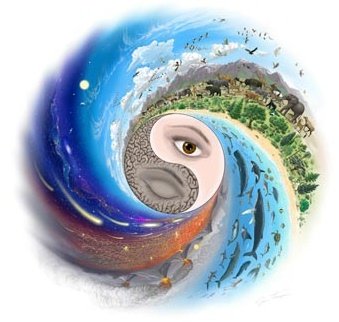 Following the wisdom of Chinese medicine and Taoïsm, we would say that living in harmony with nature is the best way to take care of our chi, our life energy. But how to live in harmony? How do we read the messages that nature sends us and adapt them to our daily life?
Following the wisdom of Chinese medicine and Taoïsm, we would say that living in harmony with nature is the best way to take care of our chi, our life energy. But how to live in harmony? How do we read the messages that nature sends us and adapt them to our daily life?
A firm first step in the good direction would be to meditate on a daily basis. Any meditative technique that helps you to be aware of this particular moment and the environment you are living in, is sufficient. If you’d like an instruction, I refer to the meditative exercise I described earlier for Yang Sheng. Meditation helps us to perceive our surrounding. Being in touch with nature is vital if you’d like to live in harmony with it.
Adapting
Living in harmony with nature is similar to adapting ourselves to the changing of the seasons and the weather. Just by looking outside we see the energies around us changing, and these changes influence our energies. In the Netherlands, where I live, it’s autumn at the moment I’m working on this article. It’s cold, humid, and windy. Some animals already started their hibernation, others are preparing to do so. So what’s the best way to adapt to this energy that is so different from the summer?
Chinese medicine provides us with brilliant guidelines of how to do this. The Five Elements gives us insight in the energetics of the seasons and the meridians that are associated to this. We can strengthen these meridians by movement, meditation, but for example also by food.
Open all the meridians
The next series of Do-In (a Japanese form of Dao-Yin) exercises are known as the ‘makko-ho’ or ‘Masunaga’ stretchings. If you practice the whole sequence, you open all the different meridians in the sequence of the ‘Chinese clock’. This is the order of activity of the different meridians within a day. Don’t bother if you can’t do every exercise to its full potential. Feeling a comfortable stretch is sufficient.
If you regulate your energy flow like this on a daily basis, this will help you to adapt to nature. Even better: work a bit more on the meridian related the the season, by tapping, stretching or massaging the particular meridians. If you don’t know where the meridians run, it’s easy to find on the web, or just tab on the areas mentioned in the exercises.
Every step we take towards harmony, will strengthen our senses and help us to be even closer to it.
1. Lung and Large intestine meridian – Metal – Autumn
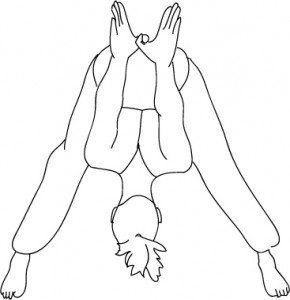 Stand with your feet a bit wider than hip distance. Toes point a bit outwards. Interlace your thumbs behind your back (hold a shawl between the hands if interlacing is not possible), tips of the index fingers may touch. Inhale, open your lungs by looking up and pulling the shoulder blades together. Lift your arms up from your back. When you exhale, bend forward from the hips, as far as comfortable. Keep the chest open and the back straight. Relax your neck. Stay in this stretch for five in- and out- exhalations opening the chest, lengthening your arms towards your thumbs. Also feeling a stretch in the back of your legs. Release tension with every exhalation. Slowly roll up to a standing position. Relax. Notice the sensation of space and vibration in your shoulders and arms.
Stand with your feet a bit wider than hip distance. Toes point a bit outwards. Interlace your thumbs behind your back (hold a shawl between the hands if interlacing is not possible), tips of the index fingers may touch. Inhale, open your lungs by looking up and pulling the shoulder blades together. Lift your arms up from your back. When you exhale, bend forward from the hips, as far as comfortable. Keep the chest open and the back straight. Relax your neck. Stay in this stretch for five in- and out- exhalations opening the chest, lengthening your arms towards your thumbs. Also feeling a stretch in the back of your legs. Release tension with every exhalation. Slowly roll up to a standing position. Relax. Notice the sensation of space and vibration in your shoulders and arms.
2. Stomach and Spleen meridian – Earth – Indian summer
 Start sitting on your knees (or read the instruction for an adaptation below). Place your hands behind your feet, lean backwards. Maybe it’s possible to sink a bit deeper, onto your lower arms, or lie all the way backwards. Always make a pelvic rotation in this exercise, this feels as if you round your lower back. This protects the lower back and intensifies the stretch on your upper legs where the Stomach and Spleen meridians run.
Start sitting on your knees (or read the instruction for an adaptation below). Place your hands behind your feet, lean backwards. Maybe it’s possible to sink a bit deeper, onto your lower arms, or lie all the way backwards. Always make a pelvic rotation in this exercise, this feels as if you round your lower back. This protects the lower back and intensifies the stretch on your upper legs where the Stomach and Spleen meridians run.
It’s also possible to stretch our legs one by one: lay on your side, support your head. Grasp the foot of the leg on top, pull the heel towards your buttocks. Again, work on this pelvic tilt.
After five in- and out- exhalations, release and notice the space and energy flow in the legs.
3. Heart and Small intestine – Fire – Summer
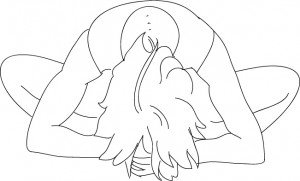 Sit on the floor. Bend your legs, bring the soles of the feet together. Put your hands around the toes, left hand on top. Take a deep inhalation, open the chest, exhale rounding forward. The head bends in the direction of the toes but doesn’t need to touch them. Don’t push yourself forward, but let the gravity work. With every inhalation, feel the space between the shoulder blades open, this area is connected to the heart energy. With every exhalation, relax your lower back and inner legs even more. These area’s are connected with the small intestine energy.
Sit on the floor. Bend your legs, bring the soles of the feet together. Put your hands around the toes, left hand on top. Take a deep inhalation, open the chest, exhale rounding forward. The head bends in the direction of the toes but doesn’t need to touch them. Don’t push yourself forward, but let the gravity work. With every inhalation, feel the space between the shoulder blades open, this area is connected to the heart energy. With every exhalation, relax your lower back and inner legs even more. These area’s are connected with the small intestine energy.
Sit up after five exhalations, feel the space and the energy.
4 Bladder and Kidneys – Water – Winter
 Now stretch your legs in front, toes point up. Bend forward with a straight spine. If it’s not possible to bend forward from you hips, bend the knees a bit. In this position we stretch the back of our legs where the meridians of Bladder and Kidneys run. Maintain the space between the vertebrae (don’t sacrifice the energy flow in the governing vessel for a deeper forward bend). Sit straight up after five in- and out- exhalations, feel the space and the energy in the back of your legs.
Now stretch your legs in front, toes point up. Bend forward with a straight spine. If it’s not possible to bend forward from you hips, bend the knees a bit. In this position we stretch the back of our legs where the meridians of Bladder and Kidneys run. Maintain the space between the vertebrae (don’t sacrifice the energy flow in the governing vessel for a deeper forward bend). Sit straight up after five in- and out- exhalations, feel the space and the energy in the back of your legs.
5 Heart Protector and Triple Heater – Fire – Summer
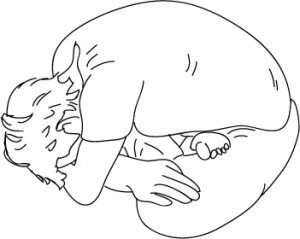 Take a cross-legged position, or a half of full lotus. Right leg on top. Inhale, circle your arms up, and place them crossed on your knees, right arm on top. Bend forward and take some deep inhalations in this self-protecting pose. This pose is more of a symbolic posture than a stretch. By circling the arms up, we clear the energy field around us. Then, bending forward with the arms crossed, we protect all our vulnerable yin-areas. This relaxes our Heart-protector energy. The stronger yang-areas of our body are outside. Breathing deep and slowly, we massage our spine, focusing on the lower belly, we strengthen the centre of our body, connected to the Triple-heater energy.
Take a cross-legged position, or a half of full lotus. Right leg on top. Inhale, circle your arms up, and place them crossed on your knees, right arm on top. Bend forward and take some deep inhalations in this self-protecting pose. This pose is more of a symbolic posture than a stretch. By circling the arms up, we clear the energy field around us. Then, bending forward with the arms crossed, we protect all our vulnerable yin-areas. This relaxes our Heart-protector energy. The stronger yang-areas of our body are outside. Breathing deep and slowly, we massage our spine, focusing on the lower belly, we strengthen the centre of our body, connected to the Triple-heater energy.
After five deep and even breaths, roll up, stretch your arms up and circle them down. Feel the calmness, the space and openness.
6. Gallbladder and Liver – Wood – Spring
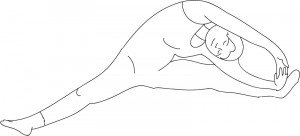 Take a wide-legged sitting posture. Swing a bit from left to right to feel which leg feels the most flexible, we will stretch this leg first. Bend to your side. Open the waist and the space in between the ribs – this opens the Gallbladder energy. The stretch on the inside of the legs opens the Liver energy. Change side after three to five breaths.
Take a wide-legged sitting posture. Swing a bit from left to right to feel which leg feels the most flexible, we will stretch this leg first. Bend to your side. Open the waist and the space in between the ribs – this opens the Gallbladder energy. The stretch on the inside of the legs opens the Liver energy. Change side after three to five breaths.
When finished feel the openness and the vibration. Take at least five minutes to meditate.
Finish the exercises by bending forward, a sign of gratitude.
 Lilian Kluivers is a shiatsu therapist and Do-In teacher and teacher trainer. She runs Do-In Academy, an international education that aims to help people use the wisdom of eastern medicine in everyday life. Lilian is an author of two books about Do-In published in The Netherlands and Belgium, an English translation of her book about Do-In will be finished mid-2015.
Lilian Kluivers is a shiatsu therapist and Do-In teacher and teacher trainer. She runs Do-In Academy, an international education that aims to help people use the wisdom of eastern medicine in everyday life. Lilian is an author of two books about Do-In published in The Netherlands and Belgium, an English translation of her book about Do-In will be finished mid-2015.

Pingback: Reflecția naturii în viața ta – partea I
Pingback: Reflecția naturii în viața ta – partea a – II – a